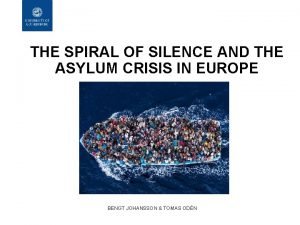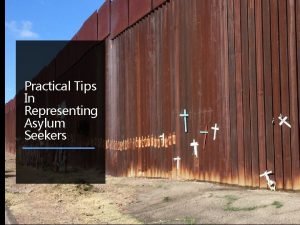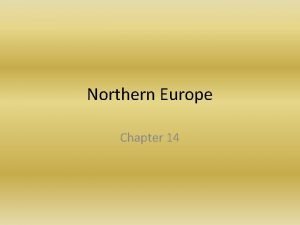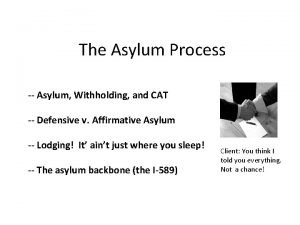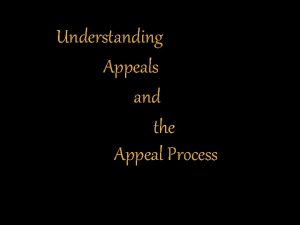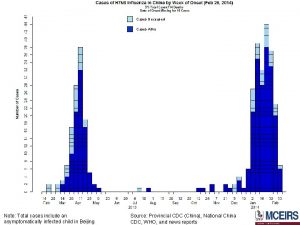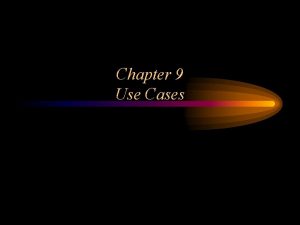The Appeal Process in Asylum cases in Sweden














- Slides: 14

The Appeal Process in Asylum cases in Sweden - a brief overview 1

Swedish courts Administrative General courts 2 Supreme Administrative Court Supreme Court 4 Courts of Appeal (1 Migration Court of Appeal) 6 Court of Appeals (1 Land Environment Court) 12 Administrative courts (4 Migrations Courts) 48 District Courts (5 Land Environment Courts)

Court district för the Administrative Court of Appeal • Gotland county (Stockholm) • Stockholm county (Stockholm) • Uppsala county (Uppsala) • Västmanland county (Uppsala) 3

Court district for the Migration Court of Appeal (and the Migration courts) Migration courts: • Administrative Court of Luleå • Administrative Court of Stockholm • Administrative Court of Göteborg • Administrative Court of Malmö 4

The Appeal Process in the Administrative Courts Authority Administrative Court of Appeal Administrative Court Leave to appeal 5 Leave to appeal Supreme Administrative Court

The Appeal Process in the Migration Court system Migration Board Migration Court of Appeal Leave to appeal 6

The Assessment In the Migration Board and in the Migration Courts • A full legal assessment by decision makers and judges with country specific knowledge In the Migration Court of Appeal • Leave to Appeal is only given - in cases which can serve as precedents, or - in cases where there is extraordinary circumstances (rare and often based on procedural errors) • If leave to appeal is granted the Court makes a full legal assessment. Usually leave to appeal is not granted in cases concerning country specific questions. 7

The Organisation of the Migration Court of Appeal President • Six divisions, whereof one specifically deals with making precedents in the area of migration and asylum Division 1 Chief Judge Division 2 Chief Judge Division 3 Chief Judge • Approximately 210 employees, about 160 of these are lawyers 8 Division 4 Chief Judge Administrative division Administrative Director Division 5 Chief Judge Division 6 Chief Judge

Employees 9 Category Number Judges 56 Co-opted members, Assistant Judges and Legal clerks 38 Reporting clerks 61 Secretaries 25 Administrative staff 30 TOTAL 210

The process of making precedents The case is heared by three judges, two from Division 1 and one from Division 2 -6 Division 1 Division 2 -6 10 If there is a case that might be turned into a good precedent it should be sent to Division 1. The reporting clerk and the responsible judge continue with the case.

Number of cases in the Administrative Court of Appeal and in the Migration Court of Appeal • Filed and determined cases 2015 : Approximately 18 600 in total (Jan-Dec 2015) 11

Common cases Largest number of cases: • Migration and asylum cases (54 %) • Taxation cases (12 %) • Social security cases (8 %) Other cases, for example (of 600 types of cases): • Social assistance cases • Driving license cases • Public procurement • Secrecy cases • Preventive detention of children, addicts and mentaly ill 12

Consequence of the current situation – any Trends? • It seems that there is • A decrease in the amount of incoming asylum cases • An increase in the amount of detention and Dublin cases, and • That leave to appeal is granted more often due to extraordinary circumstances • A large increase of appeals are expected • Perhaps what we see is the calm before the storm? 13

Questions? 14
 Worcester county asylum
Worcester county asylum The asylum
The asylum Asylum link merseyside
Asylum link merseyside Asylum case summary
Asylum case summary Bethpage asylum office
Bethpage asylum office Criminal cases vs civil cases
Criminal cases vs civil cases Ethos in martin luther king speech
Ethos in martin luther king speech Business process management cases
Business process management cases Solsystem modell
Solsystem modell Swedish csn
Swedish csn Railway network sweden
Railway network sweden Who is the prime developer of natural gymnastics?
Who is the prime developer of natural gymnastics? Northern europe geography
Northern europe geography Your first eures job sweden
Your first eures job sweden Studying in sweden as an eu citizen
Studying in sweden as an eu citizen

